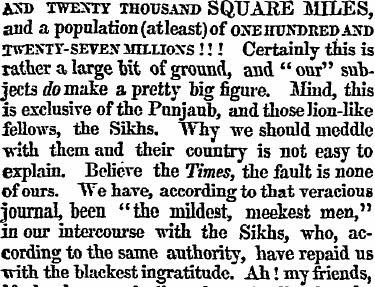
Cavalry Swords.—In the Sikh war, arms , heads, hands, and legs of British soldiers were lopped off by the enemv on all sides, while swordsmen laboured often in vain to even draw blood, let the Sikhs, it was found, used chiefly our own cast-off dragoon blades, fitted into new handles, sharpened until they had a razor edge, and worn in wooden scabbards, from which they were never drawn except in action. In such scabbards they were not blunted and they were noiseless; they made none of that incessant clanging which almost drowns the trumpet or bugle, and quite word of command, in the ranks of our own cavalry regiments; and which, unless the men wrap hay about the steel, renders any attempt at surprise by cavalry perfectly absurd. The wooden scabbard, it was found upon inquiry, are even less brittle than steel ones. A squadron of the Third Dragoons charged a baud of Sikh horsemen under Major Unett. The Sikhs let the squadron enter. A dragoon of the front rank thrust with his sword point at the nearest Sikh. The weapon broke into the skin, but did not penetrate so far as to do any serious mischief. The Sikh, in return , struck the dragoon across the mouth, and took his head off. A Sikh at Chillianwallah galloped up to the horse artillery, cut down the two first men, and attacked the third. He, seeing that his comrades had been unable to save their lives by the use of their blunt swords , left his sword in the scabbard, and fought off the assailant with his riding-whip—flogging away the Sikh's horse, to keep the fatal arm at a safe distance. So he saved himself. There can be no doubt that heavy riding-whips would be more formidable weapons in all warfare than the cavalry swords now in use.—Dickens's " Household Words."

